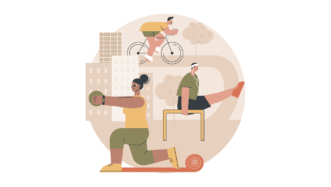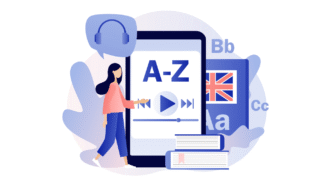LESSON OVERVIEW
The main objectives of this ESL lesson on places in town are to:
- learn vocabulary for talking about towns and neighbourhoods;
- learn adjectives to describe people;
- watch a video, listen to a recording, and practise using maps.
With this ESL lesson on places in town, students talk about neighbourhoods! They work with vocabulary for common places (e.g. police station, library, museum). They learn adjectives to describe places (e.g. historic, safe, free) and people (e.g. creative, friendly, clever). Students do activities with maps, listen to a recording, and watch a video about a neighbourhood. They also do a ‘this or that’ activity and talk about neighbourhood experiences and preferences.
WARM-UP AND VIDEO
This ESL lesson on places in town starts with a warm-up. Students look at an example of an address and replace parts in bold with their own information. Next, students look at a map and choose the best place(s) in the neighbourhood for certain activities (e.g. talk to a doctor – hospital). After that, students listen to a recording in which two speakers talk about where they live. Students need to look at the map again and say which house each speaker lives in. Next, without looking at the map, students say if some sentences are true or false. Then, they look at the map and correct the false sentences. Following that, students use words provided to name three things that are near their own houses and three things that aren’t. Then, they explore adjectives to describe places in town (e.g. safe, clean, dirty) by matching sentence halves. After that, they say if the completed sentences are true for them.
DISCUSSION AND COLLOCATIONS
At this point in the ESL lesson on places in town, students do a ‘this or that’ exercise. They choose between options (e.g. old and historic buildings OR big new buildings) and say which they like more. Next, students create two similar options to choose from for their partner. Then, they move on to adjectives for people! Students match adjectives to the sentence that describes a person (e.g. They do sport every day – active). Students practise the adjectives by choosing a person they know for each adjective. They add details if they can. After that, students watch a video about a neighbourhood and write five adjectives from the lesson that they hear. The ESL lesson on places in town finishes with a question discussion activity, in which students can talk about the video and their own neighbourhoods.
HOMEWORK/REVISION
This lesson plan also includes an additional task that you can use as homework or revision. In the task, students complete sentences with adjectives and words/phrases from the ESL lesson on places in town. The task is available in the teacher’s version of the worksheet. You can print it and hand it out to your students. It’s also included in the e-lesson plan.
WORKSHEETS
Subscribe to unlock these and many other Standalone lesson with the Premium plan
Subscribe













This lesson is excellent! I suggest an expansion or adding a few slides to work There Is/ There Are.
A lot of A1 students struggle with this construction and the lesson is perfect to practice that.
Another option is to add a lesson talking about things at home, describing furniture vocabulary + there be.
Thanks!
Thank you for the suggestions! A lesson on furniture in the house is coming this week – stay tuned 🙂
Wonderful!!!
🤗🤗🤗